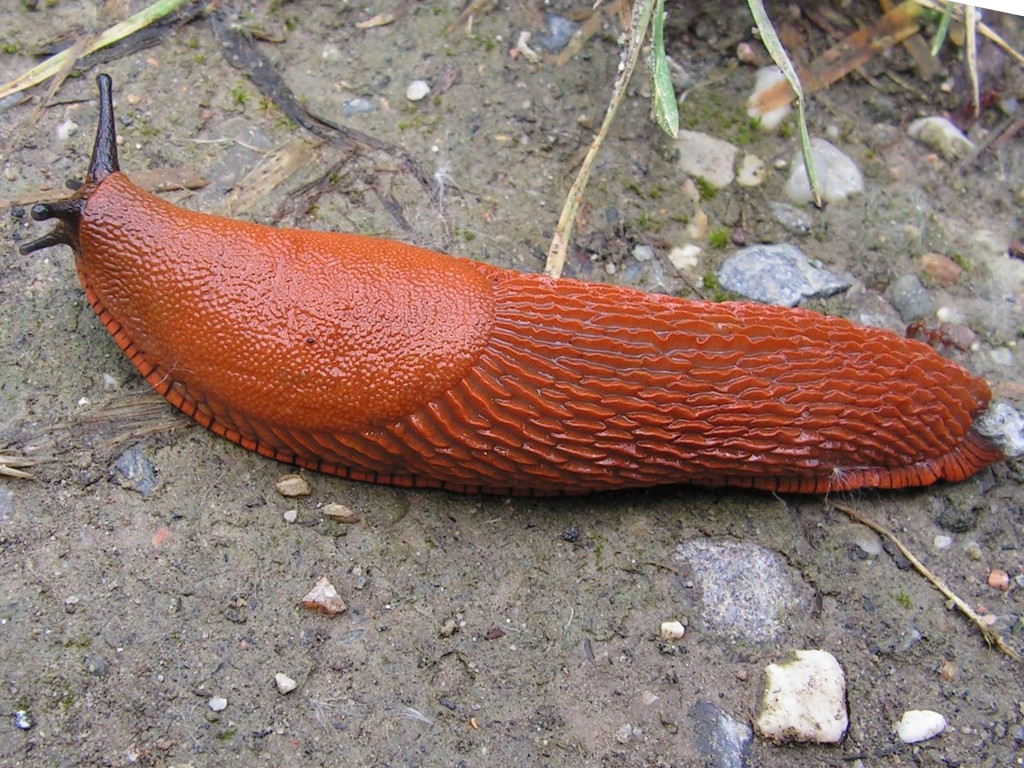
It's been a bumper year for the 10" incomers mobbing our gardens, says Sarah Rainey in the Telegraph on 28 September.
They're the slimy invaders that attack our vegetable patches and play havoc with our best begonias, leaving a glistening trail of destruction behind them. Slugs have been a blight on British gardens for decades. But this year, after the wettest summer in more than a century, we're in the midst of an invasion - and the slugs are bigger and more ferocious than ever.
"Monster slugs" from the Iberian peninsula are swarming across Britain, fuelled by the rain, which has proved ideal conditions for the creatures to grow. Slug experts report a two-fold increase in giant Spanish slugs, which can grown up to 10" long, with some gardens swamped by 200 at a time. There have been reports of these slugs gnawing on dead rabbits and invading letter boxes, where they devour the glue on stamps.
Concerned Daily Telegraph readers have flooded our post room with tales of the 'longest and fattest' slugs they have ever seen. 'Could this be because we have a nuclear facility a few miles away, and the slugs have mutated?' asks one reader in Chester. 'I have put the obesity epidemic down to my calorie-laden dahlia leaves', writes another reader from Eltham. And a Wandsworth reader explains what happened when her husband dared to confront one: 'When he foolishly picked one up with his bare hand, his punishment was to be covered in a thick slime ejected by the ugly garden pest. Slug: 1/ Husband: 0!'
There are some 30 species of slugs in Britain, the most common of which is the grey field or netted slug (Agriolimax reticulatus). These can grown up to 1.5" in length. Although they'll greedily lunch on soft fgruit and vegetables, they are unlikely to be the monstrous molluscs spotted in readers' gardens.
More common this year are two varieties that have crossed the continent: the 'Spanish stealth slug' (Arion flagellus), breeding here for 40 years, and the 'Spanish slug' (Arion vulgaris), which hitched a lift across the Channel in pot plants and salads.

'Big slugs mature at this time of year, which is why we're seeing massive amounts,' explains Dr David Glen, a slug specialist with Styloma Research and Consulting. 'They're especially big because we've had such ideal growing conditions. Not much will eat them: they have a very sticky, defensive mucus to repel predators.'
Spanish slugs can be spotted by their distinctive colour - their skin has an orangey hue and their foot sole (underneath the body) is dark. The stealth slugs, which don't grow to such lengths, tend to be green underneath, while the younger ones bear 'go-faster' stripes. The invading molluscs are 'pre-adapted to spread', explains Dr Les Noble, a slug expert from Aberdeen University. 'They self-fertilise, so if one gets into an area, you'll soon find a whole colony. Spanish slugs can lay between 300 and 500 eggs, while our native slugs only lay around 150.'
As well as chomping on cabbages, potatoes and soft fruit such as strawberries, the non-native slugs use their thousands of tiny teeth to guzzle sweet peas, beans, broccoli, courgettes and rhubarb.
They even pose a threat to the survival of smaller British slugs. 'It's a double whammy,', says Dr Noble. 'The invaders come over carrying parasites and diseases which our slugs haven't adapted to deal with.'
Slug pellets containing metaldehyde or ferric phosphate are the usual remedy (the hardware chain B&Q reports a 74% rise in sales this year), as is sprinkling salt around the flower beds - this dehydrates the slugs. Experts say hand-picking can be just as effective, killing the slugs humanely by dropping them into a bucket of hot water. 'You should clear away plant pots and piles of leaves from the outside of the house', adds Ian Miller of pest control company Cleankill.
There are many ideas for how to control (ie kill!) slugs but in the end, says Dr Glen, gardeners may be fighting a losing battle. 'Soon this year's batch will lay their eggs in the soil and die off. Their eggs will hatch over the winter and next year the invasion could start all over again.

See also http://en.wikipedia.org/wiki/Spanish_slug, http://theforeigner.no/pages/columns/the-great-norwegian-garden-slug-invasion/ and http://www.bbc.co.uk/news/science-environment-18685229
Incidentally, there was an article about this in the Daily Mail on 2 July, so they story's been around for several months.








